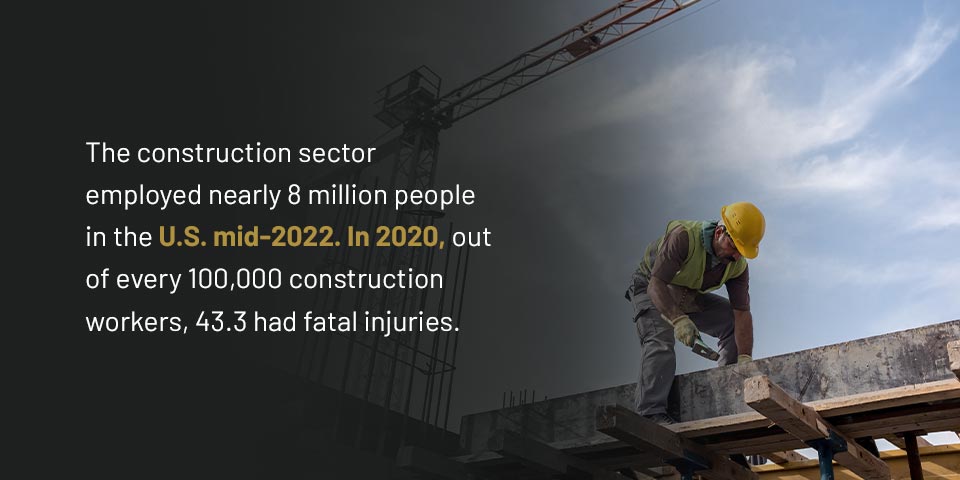Even a barista is at risk of burning a hand or suffering a slip and fall on the job, but some jobs are more dangerous than others. So, what are the most dangerous jobs in the United States? A study by the U.S. Bureau of Labor Statistics (BLS) provides the answer.
We’ll discuss the top 10 most dangerous jobs in the country, taking into account the fatality injury rate and common causes of fatality.
Top 10 Most Dangerous Jobs in the U.S.
According to the BLS, there were 4,764 fatal occupational injuries in 2020. The figure represents the lowest annual record since 2013. At the same time, private industry employers reported around 2.1 million nonfatal injuries in 2020. In 2021, injury cases increased to 2.2 million. Here are 10 industries that contributed to those numbers, ranked from least to most dangerous:
10. Farmers and Agricultural Workers
Farmers and agricultural workers are tenth on the list of the most dangerous job in America. Such employees face a fatal injury rate of 21.5 per 100,000 workers. Besides exposure to harmful farm chemicals, operating heavy machinery for extended hours has a toll on commercial farmers. This can result in crashes involving tractors. Farmers and agricultural workers, unlike those in most industries, can also include children. These children are at risk of fatal and nonfatal injury, as well.
9. Underground Mining Machine Operators
With a fatal injury rate of 21.6 per 100,000 workers, underground mining machine operators sit ninth on the list of most dangerous jobs in America. Many mining operations are conducted in cramped, underground shafts where cave-ins sometimes trap and injure workers. Rescuing workers in such conditions is a demanding and equally dangerous endeavor.
Dangers of underground mining include explosions, which can be caused by methane gas, coal dust and other sources. Transportation-related injuries and heavy machinery casualties also pose a danger to those operating mining equipment.
8. Driver/Sales Workers and Truck Drivers
The fatal injury rate of truck drivers is 25.8 per 100,000 workers — the stat includes small, medium and large-scale delivery drivers, as well. Truck and delivery drivers spend almost all of their time on the road, driving their vehicles along various routes to sell, deliver or pick up items. The very nature of the job increases the chances of transportation-related workplace accidents. While providing adequate training to workers can help save lives, this type of work still holds inherent risk.
7. Structural Iron and Steel Workers
Of every 100,000 structural iron and steel workers in America, 32.5 encounter fatal work-related injuries. The figure represents a leap from the 26.3 per 100,000 workers’ fatal injury rate in 2019. But what makes their job so dangerous?
Structural workers install iron or steel elements into buildings for construction purposes and play a vital role in the stunning architecture we see around us. The job requires them to work on lofty structures for considerably long durations. This increases the risk of slips and falls. Falling heavy objects is also another major cause of harm in the industry. While implementing emergency procedures and investing in safety equipment can mitigate some of this issue, this area remains particularly dangerous.
6. Refuse and Recyclable Material Collectors
Refuse and recyclable material collection is the sixth most dangerous job in the U.S., with a fatal injury rate of 33.1 per 100,000 workers. The job exposes workers to hazardous materials, including broken glasses, chemicals, medical needles and other sharp objects, which can result in injuries and illness. Further, some locations require these workers to serve year-round, regardless of weather conditions, posing additional risk.
More severe injuries occur from handling heavy equipment, such as trucks. Another cause of fatalities is vehicular accidents. The job requires material collectors to stop in traffic to collect trash, placing them in harm’s way. While the actual garbage truck can strike workers, causing harm, other approaching vehicles are also a threat.
5. Aircraft Pilots and Flight Engineers
Aerospace engineering and piloting rank among the most dangerous jobs in the U.S. In 2018, aircraft pilots and flight engineers recorded the second-highest fatalities in the United States, with a rate of 53 per 100,000 workers. The fatal injury rate has dropped to 34.3 out of 100,000 workers. The most common cause of injuries in the sector is transportation.
Pilots and flight engineers are experts in navigating and flying airplanes across distant locations. Their training allows them to avert several workplace injuries. Yet, there are instances where malfunctions or improper safety protocols can result in fatalities.
4. Construction Trade
The construction sector employed nearly 8 million people in the U.S. mid-2022. In 2020, out of every 100,000 construction workers, 43.3 had fatal injuries. Construction involves more manual labor compared to other industries and uses heavy-duty equipment such as articulated trucks, asphalt pavers, dozers, drum rollers and excavators.
The typical cause of work-related injuries on construction sites are slips and falls, workers being caught between objects, falling objects and highway construction collisions. Lack of safety apparel, such as masks, could cause respiratory disorders. Ergonomic injuries are also a concern — vibrating tools can cause one type of ergonomic injury known as hand-arm vibration syndrome, which can be permanent.
3. Roofers
Roofing has consistently made it on the most dangerous job lists in the country. Currently, the fatal injury rate stands at 47 per 100,000 workers. Roofers work high above the ground on top of buildings, repairing and installing roofs. This involves climbing, bending, lifting and kneeling, sometimes under hot weather conditions.
Most of the accidents roofers encounter are slips, trips and falls, which result in minor to severe injuries. Roofers’ typical injuries include head or brain injuries, puncture wounds, burns, electrocution and broken bones.
2. Logging Workers
Logging workers recorded a fatal injury rate of 91.7 per 100,000 workers, making it the second most dangerous job in the country. Loggers spend hours in the forest and in harsh environmental conditions.
Logging workers operate in close contact with heavy machinery and trucks to fell large trees. Besides receiving injuries from equipment use, falling trees are also dangerous for employees. There are instances where other falling objects or tree branches cause harm to loggers. An added hardship is that logging workers often operate in areas far from medical care. This distance makes it challenging to provide the necessary treatment or assistance if an accident occurs.
The Occupational Safety and Health Administration (OSHA) requires employers to provide first-aid training, offer more types of personal protective equipment, employ comprehensive manual felling procedures and adopt requirements for using protective structures. Despite these precautions, logging remains near the top of the list.
1. Fishing and Hunting Workers
Fishing and hunting working is the most dangerous job in America, with a fatal injury rate of 132.1 per 100,000 workers. Professional fishers use heavy machinery, traps, reels and nets on vessels to collect fish on commercial bases. The task they perform is critical, but it poses several health challenges.
Fishing involves intensive, physical labor that requires adequate safety measures. Fishermen spend long hours on rough waters. This causes fatigue, which can result in fatal injuries. Many accidents that occur result from boat and machine incidents and falls from vessels.
Injured On the Job and Ready to File a Workers’ Comp Claim?
Besides hiring skilled personnel to conduct operations, employers must provide safe systems of work, safety tools and regular training to protect workers and reduce workplace injuries. If you get injured while performing a work-related duty, you have up to 120 days to report an injury for workers’ compensation in Pennsylvania and no longer than three years from the date of injury to file a claim. Employing the services of experienced attorneys is a significant step to helping you get what you deserve.
Frommer D’Amico is a workers’ comp law firm in Central Pennsylvania committed to assisting injured workers. Our attorneys are available 24/7 to help you through challenging times. If you want to learn more about workers’ comp in Pennsylvania or need help with claims processing, contact us today.



